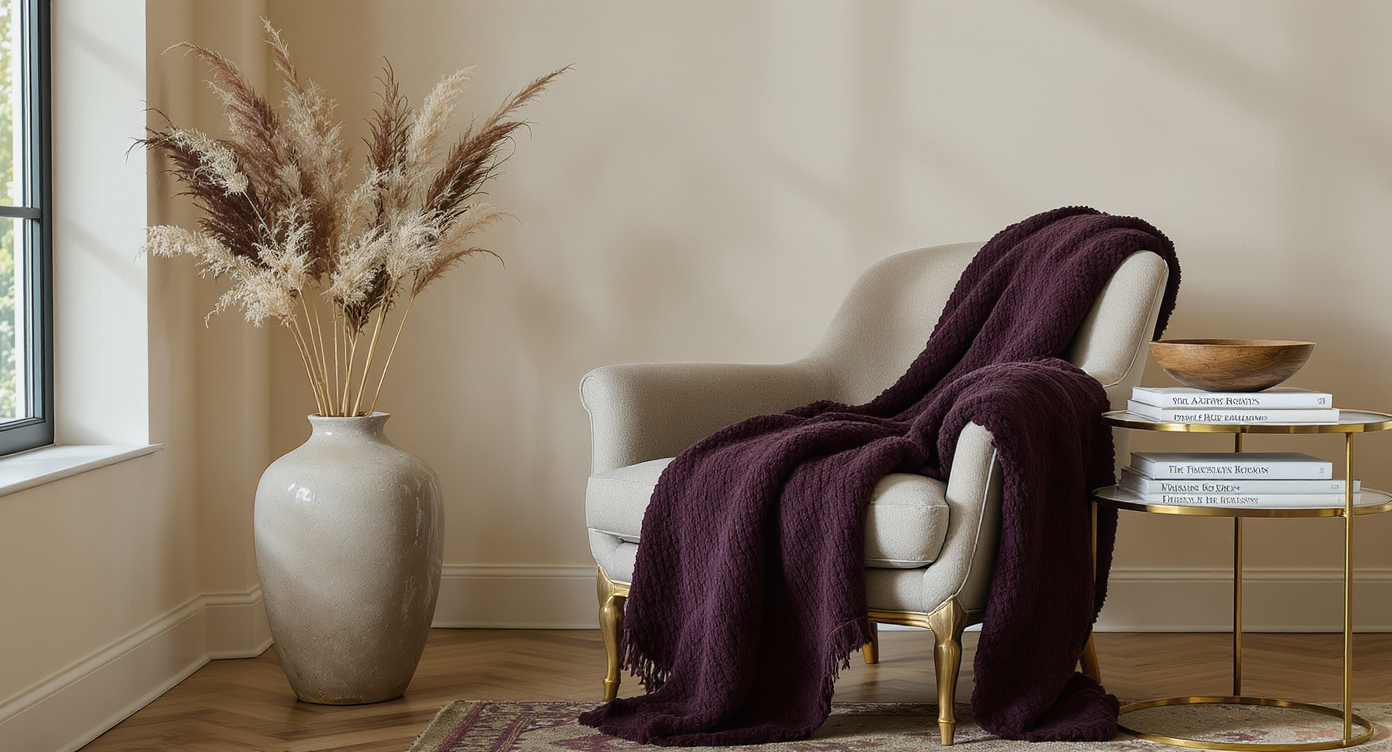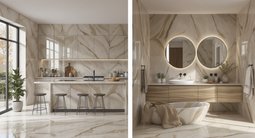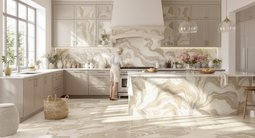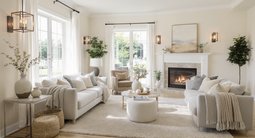TL;DR
Expect earthy color palettes, handcrafted textures, and vintage furniture to define fall 2025 interior design trends, while shiny chrome and cookie-cutter sets fade. To decorate with earthy colors without darkening a room, balance deep tones with warm whites, natural light, and layered textiles. Mix metals in a 70/30 ratio, curate a collector’s display, and choose soft curves over hard angles for a welcoming feel.
Why fall 2025 design trends matter

Layered textures and earthy accents create a cozy, curated corner perfect for fall.
Fall interior design is shifting toward homes that feel personal, curated, and grounded. Think earthy color palettes, layered textures, vintage furniture, and handcrafted decor—plus softer curves and friendlier metals. The looks that are out? Fast-fashion design, hyper-reflective chrome, and matchy-matchy sets.
Here’s the thing: a trend is only worth trying if it makes your home feel better. This season’s “ins” do exactly that. Deep tones like burgundy, plum, and mocha are back, but they live alongside creamier stones and warm whites so rooms don’t feel heavy. Textiles get thicker, glazes get matte, and the whole space reads like a retreat rather than a showroom.
Suggested image alt text: earthy color palette living room with burgundy, plum, and mocha color drenching. Caption: Rich, organic hues feel calm when balanced with warm whites and texture.
How to bring fall 2025 interior design trends home
Use the 60/30/10 palette rule and layer 5–7 textures per room for instant fall warmth. Designers often advise starting with color, then building touchable layers so the space feels collected rather than contrived.
1) Build an earthy palette that breathes
Choose one grounded hue (think terracotta, forest green, or deep brown) as your 60 percent, a creamy stone or warm white as your 30 percent, and a saturated accent (plum, russet, moss) for the 10 percent. For color drenching, keep walls, trim, and doors in the same family; shift sheen instead of hue. Rooms feel cozy when the main paint color’s LRV is under 40 and balanced by warm whites and natural light.
Suggested image alt text: color-drenched bedroom in deep plum with warm white bedding. Caption: One palette, varied sheens; the result is enveloping, not heavy.
2) Layer handcrafted textures
Mix at least five textures: wood grain, stone or matte ceramic, a nubby wool or bouclé, linen drapery, and one metal with patina. Drapery should be 2.0–2.5x fullness and hang 4–6 inches above the window trim; lined panels add warmth and look intentional.
3) Mix metals with intention
Hyper-shiny chrome is out; aged brass, bronze, pewter, and polished or aged nickel are in. Use a 70/30 blend: pick one dominant finish and a secondary to add depth. Vary sheen (aged, brushed, matte) to avoid the “one-note” hardware look.
4) Curate a collector’s display
“Collectors’ layering” beats decorator kits. Style coffee tables and mantels in odd numbers (3 or 5), vary heights by 3–8 inches, and mix materials. Original art, even a single 18×24 piece, brings more soul than a wall of mass-printed canvases.
5) Favor soft curves and human-friendly forms
Trade hard edges for rounded sectionals, barrel chairs, and pillowy ottomans. Maintain 36 inches of walkway clearance, and anchor with a rug that leaves 8–12 inches of bare floor at the perimeter; at least the front legs of sofas and chairs should sit on the rug.
6) Bring in vintage and “fewer, better” pieces
One vintage element in every sightline keeps rooms from feeling new-and-nowhere. Reupholster before you replace; a moss-green velvet on a classic chair can flip a room’s mood faster than repainting everything.
User insight: Swapping a neutral anchor for a bold-toned piece (like a russet sofa) is the fastest way to reset the room without a full redesign.
Suggested image alt text: moss-green velvet armchair, aged brass floor lamp, layered wool rug. Caption: Texture and patina make modern rooms feel lived-in.
Anecdote
A painter’s shortcut that worked. A homeowner painted walls and trim the same olive tone, bumping trim to satin sheen. With a single change, the room felt wrapped and restful—proof that sheen shifts can be as powerful as new color.
Common mistakes and misconceptions
Avoid three traps this fall: undersized rugs, over-shiny finishes, and bare windows. These mistakes make rooms feel cold, thin, and temporary.
- Buying the “set.” Matching furniture sets flatten character. Mix silhouettes and eras; keep one common thread like wood tone or fabric temperature.
- Overdoing shine. Too much chrome or mirror reads chilly. Cap high-gloss elements at about 10 percent of the room and balance with matte glazes and patinated metal.
- Bare windows. Naked windows are passé for cozy spaces. Hang lined drapery 4–6 inches above the frame and extend the rod 8–12 inches past each side to make windows look larger.
- Rugs too small. If the front legs don’t land on the rug, it’s likely undersized. Living rooms typically want 8×10 minimum; large spaces often need 9×12 or 10×14.
- Art hung too high. Aim for 57 inches on center (gallery rule of thumb) or align the lower third of art with the back of the sofa for visual cohesion.
Pro tips and expert insights
Experts recommend testing color in daylight and setting lighting between 2700–3000K for a warm, flattering glow. Small technical choices quietly transform how rooms feel.
- Sample boards, not swatches. Paint two 24×36 foam boards and move them around for a week; light changes everything.
- Layer your lighting. Use at least three sources per room: overhead, task, and accent. Dimmers let you pivot from work to wind-down in seconds.
- Sheen strategy. For color drenching, keep walls eggshell or matte, trim satin, and doors semi-gloss; same hue, different sheen creates depth.
- Seasonal swap box. Store summer linens and bright ceramics; rotate in wool throws, matte pottery, and aged metals each September for instant “fall mode.”
- Metal map. Repeat each metal at least twice so it feels intentional: the lamp, a frame, and a tray, for example.
Reflection: The rooms that age best aren’t “perfect”; they’re edited. If everything winks, nothing glows.
Anecdotes and real stories
Small swaps like replacing chrome with aged brass can shift a room’s perceived warmth overnight. Real homes prove it.
A chrome-to-brass turnaround. A couple with a glass-and-chrome living room swapped in an aged-brass floor lamp, a hammered bronze bowl, and matte pottery. The same sofa looked richer; friends asked if they had repainted. They hadn’t—texture did the heavy lifting.
The one-piece mood flip. A renter traded a beige loveseat for a russet velvet sofa and added cream drapery. No paint, no renovation, but the palette suddenly felt intentional and autumnal.
Collected mantel, collected life. A frequent traveler grouped three small ceramics, a vintage mirror, and a branch cutting. The mantel finally told a story—and it’s one visitors ask about during every dinner party.
Old meets new—and sings. A sleek low-profile sofa from years past took on new life against textured grasscloth and a stone console. Mixed eras brought warmth without sacrificing clarity.
Suggested image alt text: styled mantel with small ceramics, vintage mirror, and branches. Caption: Odd-number groupings create rhythm and calm.
Tools & inspiration
Test layouts, color drenching, and layered textures in minutes with ReimagineHome. Upload a photo, try earthy palettes, swap metals, and preview vintage-meets-modern furniture before you buy.
Visualization Scenario
Picture an evening scene: a moss-green velvet armchair angles toward a rounded sectional, terracotta drapery glows in lamplight, and an aged-brass sconce kisses the wall in warm 2700K. A marble bowl anchors the coffee table beside stacked books and a handmade ceramic. The room hums—quietly alive, layered, and utterly yours.
FAQ
What are the top fall 2025 interior design trends?
Earthy color palettes, layered textures, vintage furniture, handcrafted decor, soft curves, and warmer metals define fall 2025 interior design trends. Shiny chrome, fast-fashion furniture, and cookie-cutter sets are on their way out.
How do I decorate with earthy colors without darkening my room?
Pair deep hues with warm whites, mirrors with matte frames, and generous lighting at 2700–3000K; keep 60/30/10 proportions for balance. Use linen or sheer drapery to maximize daylight and add reflective stone or light-toned rugs.
What metals are in style for fall interiors?
Aged brass, bronze, pewter, and polished or aged nickel are in; hyper-reflective chrome is out. Use a 70/30 mix of two finishes and repeat each finish at least twice in the room.
How do you mix vintage furniture with modern pieces?
Unify by color temperature or wood tone, then vary era and silhouette for interest. Designers advise one vintage element in every sightline and avoiding matching sets.
How do I layer textures for a cozy living room?
Combine 5–7 textures—wood, stone or ceramic, wool or bouclé, linen, and metal with patina—for depth. Lined drapery and a substantial rug ground the space and improve acoustics.
The bottom line
Aim for fewer, better pieces, a grounded palette, and tactile layers. Fall 2025 design trends aren’t about buying more; they’re about tuning your home to how you actually live. Choose earthy tones, add handcrafted texture, mix metals with restraint, and let collected objects carry your story. When a room feels like you, it’s always in.
Ready to visualize it? Mock up your space with ReimagineHome and see how earthy colors, layered textures, and vintage furniture look together—before you move a single chair.
.svg)

.svg)














.png)